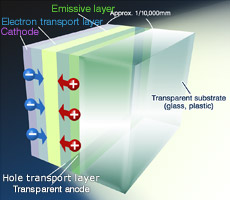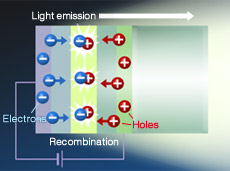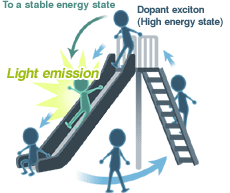The term “OLED” is becoming an increasingly familiar sight. Its practical application in mobile phone displays has begun already, and it is being touted as the favorite to succeed LCD and plasma in next-generation slim TVs.
OLED is so revolutionary that in the field of illumination it is being hailed as “the first discovery since Edison.”
What is OLED?
OLED stands for Organic EL (Electro-Luminescence), and is the phenomenon of light emitted by organic materials to which a voltage has been applied. The molecular structure of organic materials has limitless combinations, each of which varies in its color and durability.
Research into causing organic materials to emit light electrically has been going on for more than 20 years, with the increased attention currently being paid to OLED signifying that at last researchers have begun to discover organic materials that possesses the light emission efficiency and durability suitable for use in illumination and displays.

Surface construction of OLED illumination
The construction of OLED consists of laminated organic thin films laid on top of a substrate. Put simply, it features a thin, simple construction where organic materials are sandwiched between two electrodes and laid on a glass or plastic substrate.
To be more specific, the organic device is normally constructed of three layers. An emissive layer is sandwiched between two transport layers that come into contact with the cathode and anode respectively. The function of the transport layers is to carry the electric charge smoothly from the respective electrodes to the emissive layer.

Light emission principle of OLED illumination
When a voltage is applied to OLED, the holes and the electrons are generated from each of the two electrodes, which have a positive and negative electric charge respectively. When they recombine in the emissive layer, organic materials make the emissive layer to turn into a high energy state termed “excitation”. The light is emitted when the layer returns to its original stability.
The combinations of molecular structure in organic materials are limitless. Within these limitless combinations, identifying organic materials that provide high efficiency and long life will determine its practical application.
Conceptual illustration of the flow of light emission

The flow of light emission can be illustrated by the concept of a person going down the big slide. The state of sitting on the top of the slide corresponds to excitation, and the act of sliding down corresponds to light emission. To emit light continuously for 10,000 hours means that the organic material of the emissive layer repeats this act without interruption over several hundred million of times.
Using a phosphorescent substance with high light emission efficiency to artificially synthesize organic materials that can withstand a billion repetitions of light emission, Konica Minolta has succeeded in developing OLED that possesses light emission efficiency and long life on a par with fluorescent lamps.

